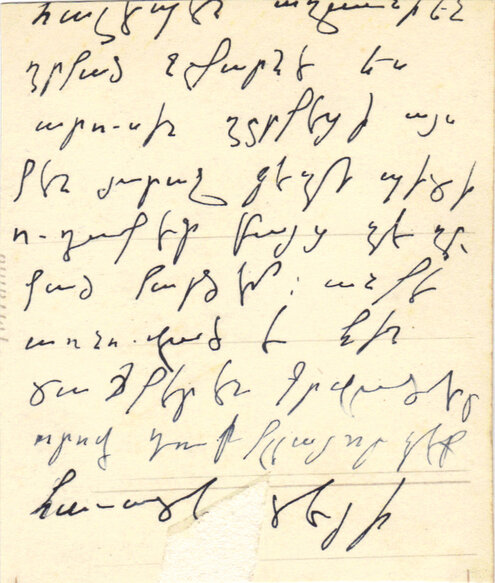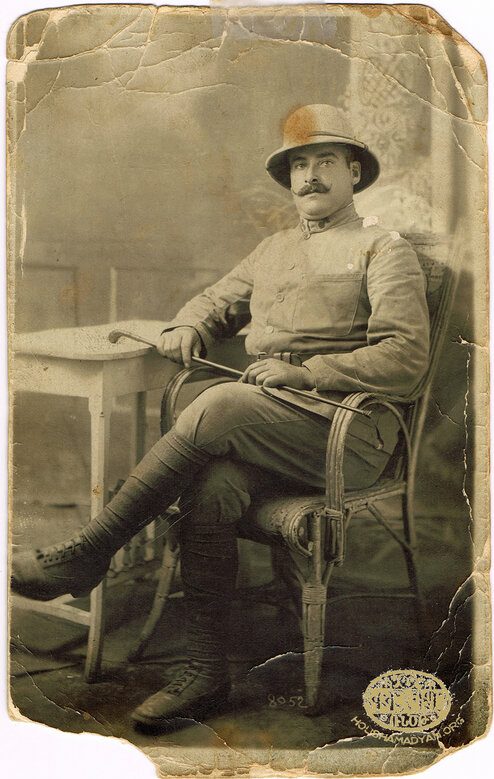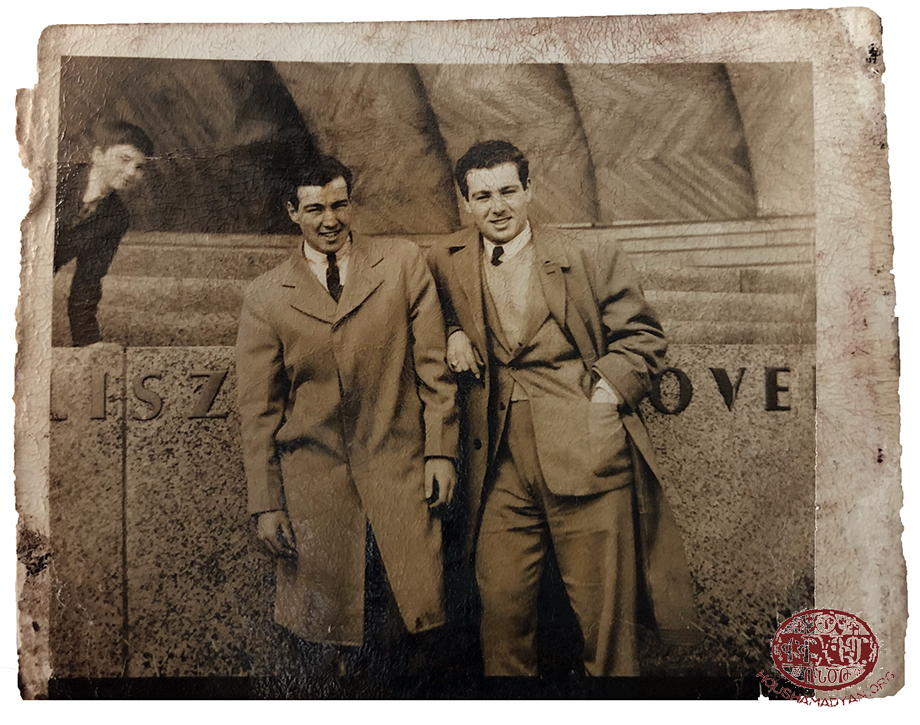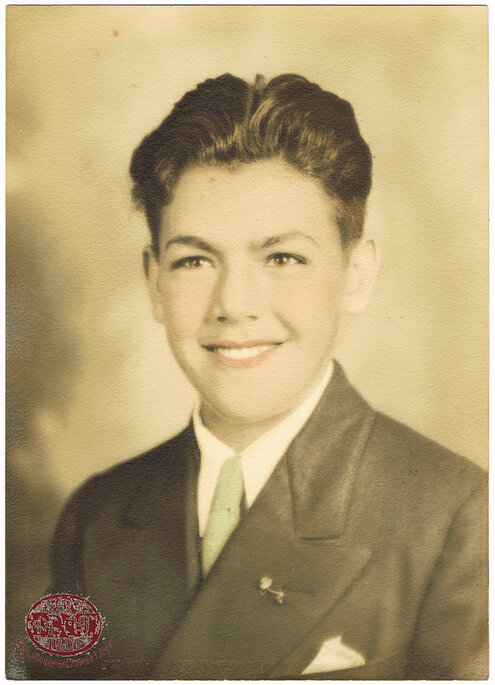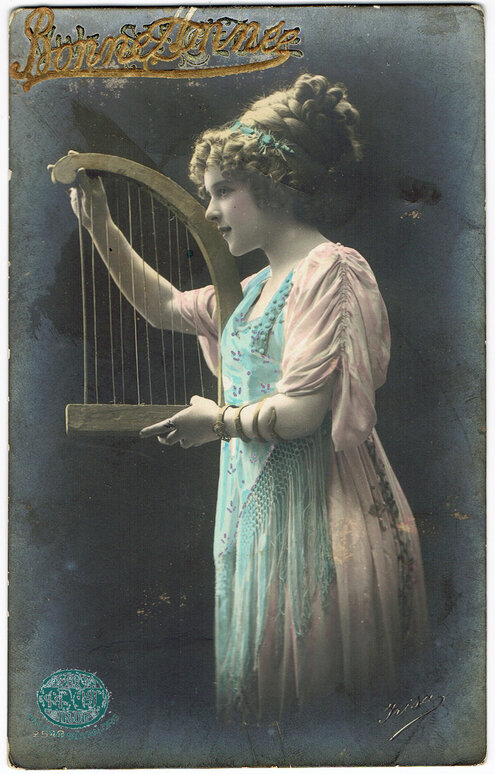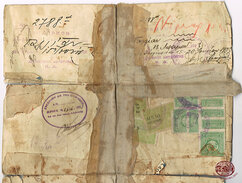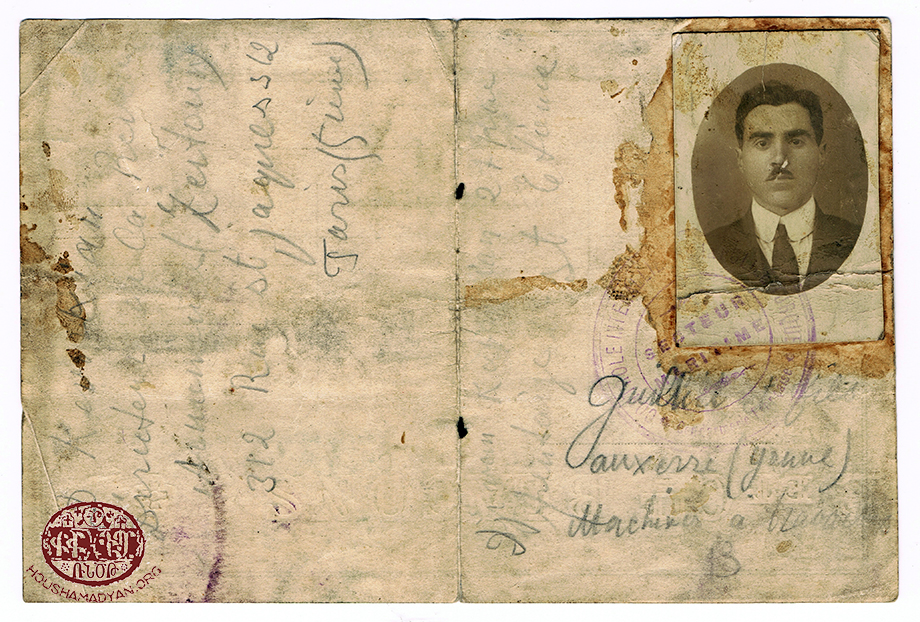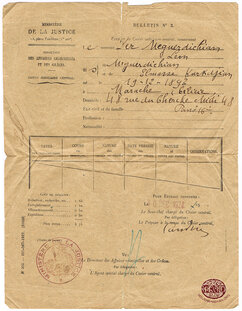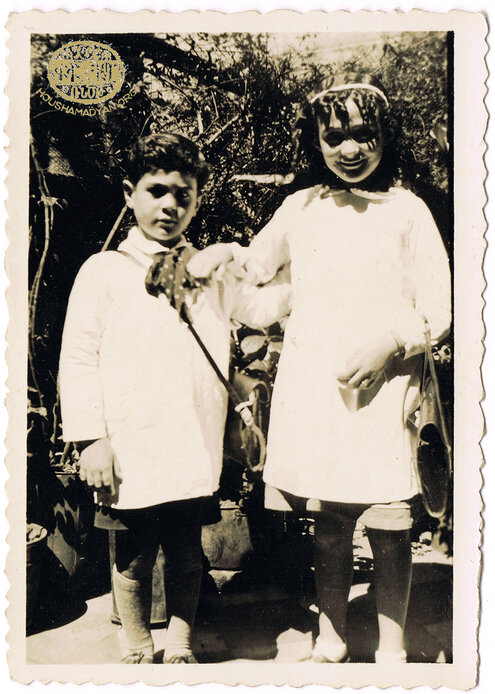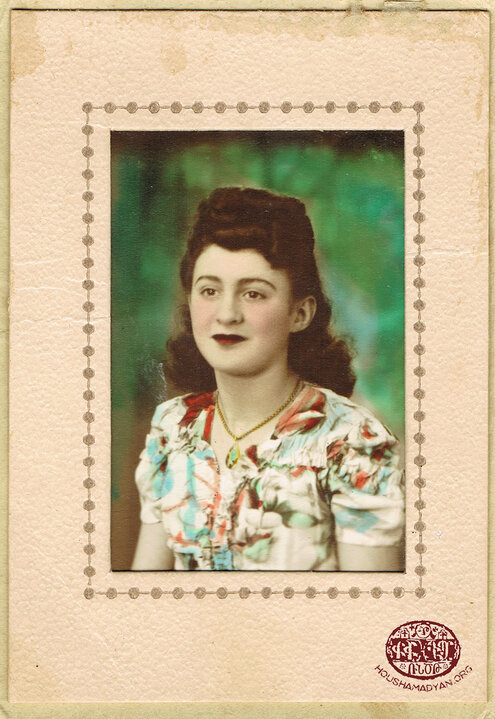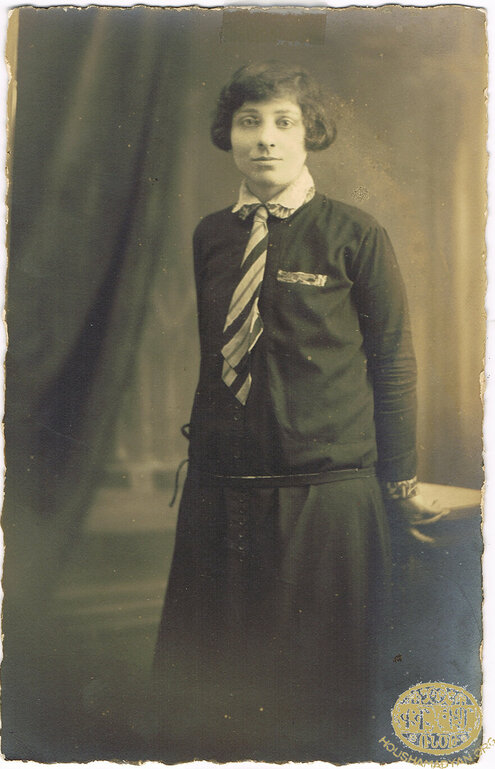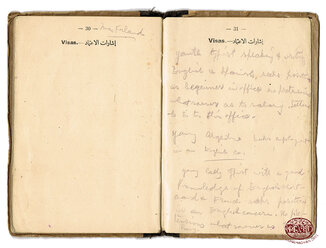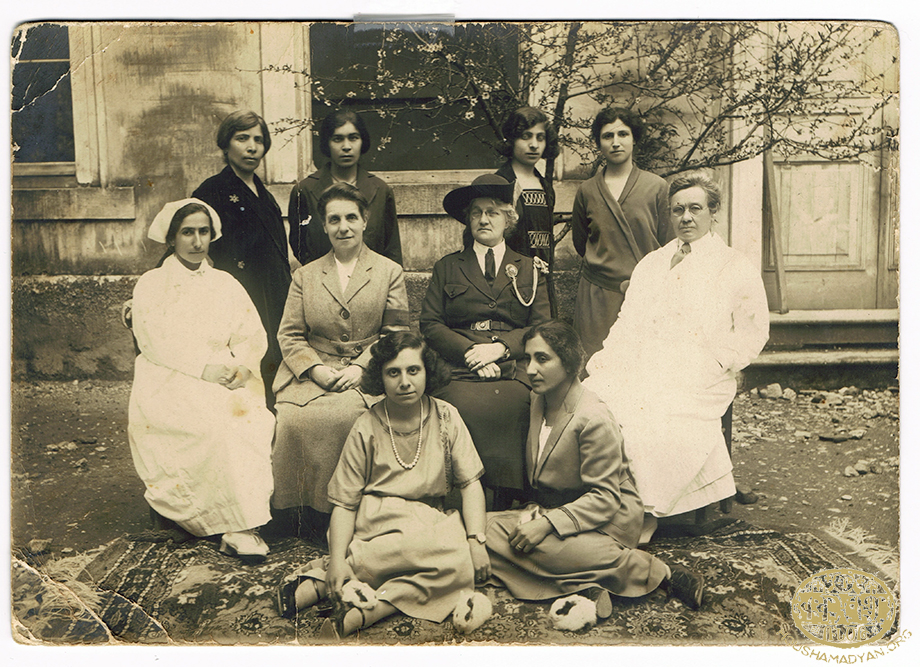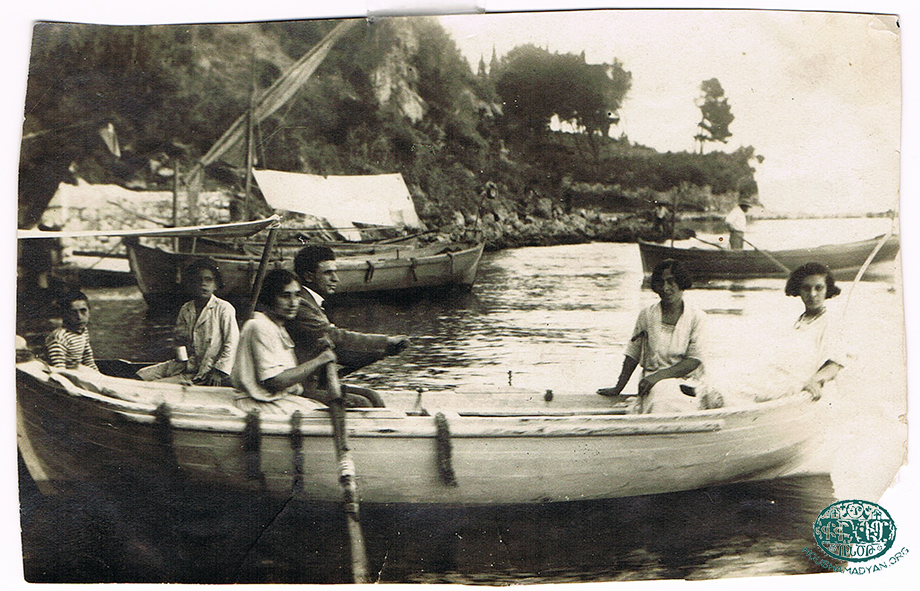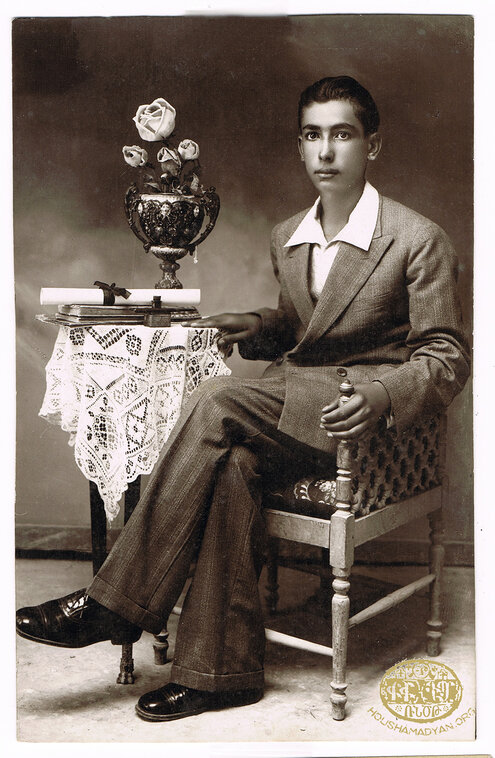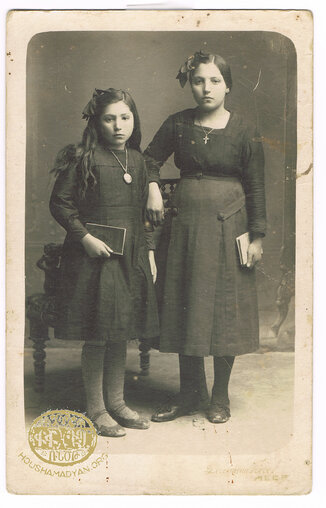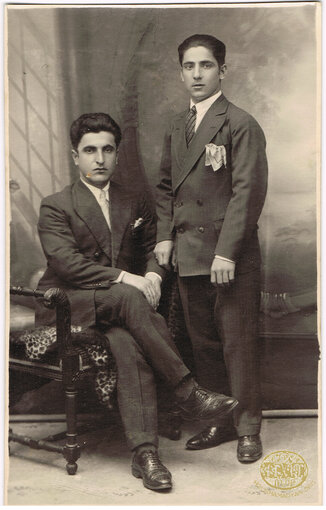Der-Meguerditchian collection - Berlin
Text by Silvina Der-Meguerditchian, with the support of Milton (Mugerditch) Zara.

In this article, we show photographs and materials that belong to the Der-Meguerditchian collection located in Berlin. The collection opens with the image of Aghavni Tenguerian, Levon Der-Meguerditchian, his mother Elmass Kurkdjian/Der-Meguerditchian and the three children of the couple - Anahid, Juan and Mario. Levon and Aghavni met and married in Paris, where they had their first child Anahid. In the end of 1929, they left Paris and settled definitively in Buenos Aires.
Aghavni’s family was originally from Sivas/Sepasdia. Her father Melkon was killed in 1915 during the Genocide, her mother Takouhi Agopian and siblings were deported. From a group of five, mother and four children, only Aghavni and her sister Shenorhig survived the death march.
The Der-Meguerditchians had a big general store and farmland in Marash. During and after WWI, Levon was able to survive and travel using his language and trade skills. He mastered seven languages. Between 1921 and 1923, he tried to settle in Istanbul, but in 1923, after the signing of the Lausanne Treaty, he realized that he had no future in the new Republic of Turkey and left the country for Paris to never go back.
This page shows Aghavni's and Levon's families in two sections. Please take note that the spellings of the names are changed according to the Spanish transliteration.
I would like to specially thank my uncle Mario Der-Meguerditchian (based in Buenos Aires) who put the suitcase with all the family photographs and documents at my disposal, and my uncle Milton (Mugerditch) Zara (based in Chicago), whom I have never met personally but with whom we have been in contact since 2011; Milton told me many stories about the Tenguerian family that I now share with you.

The Tenguerian branch (Sivas/Sepasdia)

The Tenguerian siblings
The earliest accounts about the Tenguerian family that we know, go to the couple Hovsep Tenguerian (born around 1850) and wife Vartanoush (surname unknown), based in the city of Sivas/Sepasdia.
The couple had three children:
- Melkon, born in 1867 in Sivas, hanged in Sivas in 1915.
- Samuel, born in 1885 in Sivas, migrated prior to the Genocide to the US, died in 1945 in the USA.
- Shamel, born in 1877 in Sivas, she was able to escape and after a few years in Istanbul, she went to France with her daughter Arousiag. She died in 1940 in Paris.
- Seran/Siranoush Tungrian was born in 1891 in Sivas; her father was Melkon's uncle. When he died around 1906, Melkon took Seran and her brother Joseph (named after Hovsep) into his family. This is why they used to call Melkon "hairig" (father in Armenian).

Melkon Tenguerian
Melkon was called "kepaji" which probably means: tailor specialized in coat sewing. The name Tengerian could also come from "tencere" (pot or pan in Turkish). He married Takouhi Agopian. Melkon and Takouhi had four children – three daughters: Aghavni, born 1903, Shenorhig, born in 1905, and Oghadur born in 1909, and a boy called Haigaz, born in 1912. The little boy's name was Haigaz but nobody called him by his name. Takouhi, his mother, used to make choereg (a kind of pastry), which the boy simply adored and used to constantly ask for it, but he had a speech impediment and could only say "gureg gureg dur" (give me gureg!) so everyone, including Melkon, called him "Gureg".
From verbal account through Hovsep, Melkon’s nephew, we know that in 1915 caravans of people marched through Sivas towards the south. Everyone was aware of the directives issued by the Ottoman authorities but it was hard to believe it. Melkon had a confrontation with the local gendarmes sometime in March of that year; in 1915, he was hanged by the local authorities.
Shenorhig remembers that in July, the Ottoman authorities came to the house and announced that the family members had to get ready to move out. There was a lot of crying and hysteria. Takouhi was tough. The day of their departure arrived and the mother and children were taken out of the house and thrown in with the others being deported. Takouhi, Aghavni and Shenorhig were banded together with a long line of people. Their little sister Oghadur got lost in the crowd early and they never saw her again. Their brother "Gureg" disappeared shortly thereafter and Takouhi was not allowed to get out of line to find him.
Shenorhig does not remember how long the march took or where they were, but it was long. They would sleep on the bags they were carrying. She remembers being very thirsty. After some time, their mother Takouhi dropped her belongings and sat down. Aghavni tells that her mother sat down to sleep and to never stand up again. A gendarme told the two girls to march on and that the mother would catch up with them later... More time passed, and during a commotion, the sisters lost track of each other.
Days later, while the people being deported were resting in a farm area, a man and woman came and took Shenorhig to a house some distance away. They were Kurds and had three children. Shenorhig had difficulty understanding them as they spoke Kurdish. The family tried to Islamize her; she did what they wanted her to do but never lost her faith. To “confirm” her change to Islam, they had her tattooed. They held her tight while somebody tattooed her face. They used some blue rug dyes and made the marks with nails and sticks. They made some 30 dots around her mouth and on her upper lip. They marked arrows on the sides of her mouth, and then they inked the crescent moon on either side of the cheek. They also added some Muslim designs at the edges of her eyebrows. One single dot was made on the side of her nose, and they carved inscriptions in blue ink on her right wrist. She fainted and does not remember much after that.
After some time, she does not recall how long, while Shenorhig was working in the farm fields and several men noticed her facial markings, they approached her and asked if she was Armenian. They took her to an orphanage where other children spoke Armenian.
Shenorhig’s sister Aghavni tells that she was taken to a Turkish family to work as a maid. They tried to Islamize her and that she forgot her real name, but she used to write her name and other notes in Armenian on little pieces of paper, roll them and hide them in a stonewall. It is unknown how she went to Aleppo and later to an orphanage in Beirut. It was decided that both sisters would go to the US to get shelter and live with their uncle Samuel.

Samuel Tenguerian
At an early age, Samuel left Sivas/Sepasdia after arguments with his father, uncle and brother Melkon, who urged him not to go. We don't know what Samuel's destination was at that time, however we know that after the outbreak of WWI and the news of collective massacres against the Armenians in the Ottoman Empire, he went to Egypt, where he was enlisted in the Légion d'Orient, which later became the Armenian Legion. The latter was an auxiliary military unit to the French army stationed on the Egyptian front against the Ottoman army. He fought in Syria and was assigned as a cook. He made friends with many Armenian comrades who found each other after the war to continue a lifelong friendship.
Upon his release from service, due to medical conditions, he journeyed to Cairo, found his future wife Dikranouhi (born in 1902), married her in France and settled in New York city.

In 1921, Samuel Jr. was born and was raised by Dickranouhi and Shenorhig. The family moved to Watertown, Massachusets in the 1930's. During World War II, Sam Jr. worked as a welder on liberty ships, having been deferred from military service due to family hardship. However, he was called to service in the 1940's, soon after, his regiment was shipped to the European operations. He was killed in action in Belgium in 1945. A younger brother, Tony (Antranik) lived with the family in Masachusetts until the deaths of Dickranouhi in 1942 and Samuel in 1945. Then he was taken in with Shenorhig's family. She had married Haig Zara (Zaratzian) another escapee of the Genocide. Tony raised his family of 2 boys and 2 girls in New Jersey, USA until his death in 1990.

Shamel Tenguerian
Shamel Tungrian/Tenguerian married Serop Kambourian (killed in 1915 in Sivas). They had three daughters. In 1912, one of them, Arousiag, married Karekin Andreassian at the age of 17 in Sivas, and thanks to this union, she survived the Genocide. For details of this episode and about the family, see the Andreassian collection of our Open Digital Archive (ODA). During the deportations in 1915, the two other younger sisters were kidnapped by Kurds on the road. Since then, we have no news of them.

Two sisters at crossroads
As stated above, Shenorhig and Aghavni were the only two survivors and had to join their uncle Samuel in the US. On the way to the US, Aghavni stopped at her aunt Shamel and cousin Arousiag's house in Paris.
There she met Levon Der-Meguerditchian and married him. The couple migrated to Argentina towards the end of 1929.
Shenorhig went directly to the US passing trough Marseille.
Shenorhig
Samuel helped Shenorhig go to the U.S. He sent her money for her boat trip, helped her get through customs on Ellis Island, New York and brought her to his home in 1920 where she became his ward.
Shenorhig stayed with him and his wife until she married another Armenian escapee, Haig Zaratzian (born Sivas/Sepasdia in 1899, passed away Miami, Florida 1987) in 1925 and settled in New Jersey, USA to raise their family.
Aghavni Tenguerian
Aghavni went from an orphanage in Beirut to Paris. She stayed at her cousin Arousiag’s house. Arousiag’s son, Jacques, Aghavni’s nephew, recounts that she was a beautiful young bachelorette who aroused the interest of various fellow countrymen, but she didn't want to marry very soon.
Finally, she met Levon Der-Meguerditchian and she agreed to marry him. Levon had moved from Istanbul to Paris in 1923 and had opened a hosiery shop on Rue du Cherche Midi, 48 in Paris.


The Der-Meguerditchian branch (Marash)
Meguerditch Der-Meguerditchian married Elmass Kurkdjian, daughter of Toros Kurkdjian and Hatoun Ossardjian (born in August 1881). Elmass and Meguerditch had two children, Levon born in 1894 and Koharig born in 1901. At the age of 6, during an assault in their home, Levon lost his father. His mother hid him in the closet to protect him and while he was in the closet his dad Meguerditch was killed. Despite this tragic incident, Levon and Koharig were raised in a wealthy environment and attended good schools. Levon used to ride a beautiful white horse to check the fields. The family was generous and distributed part of the harvest to their workers. The people liked Levon and called him “the Lord on the white horse.” Every day Levon would ride out on his white horse.
His sister Koharig attended the American Central Turkey Girls’ College in Marash.
We don’t know which school Levon attended, but it was surely not a Turkish and/or Armenian school, he had foreign language skills in French, English, German and Arabic.
Sometime during WWI, Levon was taken into custody. While in captivity, it happened that Levon listened closely when a guard shouted an Arabic name at the crowd in Arabic telling that the person is free to go; there was no reply, thus Levon seized the opportunity and pretended to be the man. Afterwards, he hid himself tight between the thick branches of a pomegranate tree and waited for two more days till he made sure nobody would look for him anymore. This won’t be the last time that proficiency in many languages, including French, saved his life.
Thanks to his personal papers, we know that after WWI Levon travelled to Cilicia and Arabic speaking regions with documents with the label “french protégé”.


In 1921, the desire to settle down brought Levon to Istanbul. He opened a bussines and registered in the Chahdji Khan. But before the establishment of a Kemalist regime in Istanbul in 1923, he decided to leave Turkey and boarded a ship for Marseille.

1. Levon Der-Meguerditchian’s baptism certificate, issued by the Catholic Armenian Patriarchate, Constantinople, 1922. The document is signed by Bishop Jean Naslian.
2. Certificate of good standing issued by the Armenian Church of Paris, signed by the Bishop Vramshabouh Kibarian (Archougents), Paris, 1927.


In Marseille, Levon worked at the customs and took a job at the French company Renault. After one and a half years, his savings enabled him to move to Paris and open up a hosiery shop on 48, Rue du Cherche-Midi. Levon felt ready to start a family.
Levon married Aghavni Tenguerian in Paris.

In 1928, after six years in Paris and having a premonition that a new world conflict will happen, the Der-Meguerditchians left France for good with their first new born child Anahid and settled down in the Buenos Aires neighborhood of La Boca, a favela inhabited mainly by European immigrants by the port/harbor of Buenos Aires. In the 1930’s, Argentina was known as a rich and fast-growing country, which made it a popular destination for immigrants.

Back in the day, only few were prepared to live in favelas such as La Boca, but the Der-Meguerditchians had no choice. They had to live in a conventillo – a dwelling made of corrugated iron erected for the new immigrants – in difficult conditions. Levon earned a living as a cab driver. In 1932, their first son, Hovhannes, was born. When their youngest son, Mgrditch, was born seven years later, thanks to dedication and hard work, the family moved in the Buenos Aires suburb of Claypole to a house with a big garden and was eventually able to open up a shop.
Regarding the family members from the side of Elmass Kurkdjian, Levon’s mother, we know that she had a sister who also migrated to Cordoba, probably married to a Sarafian (both names unknown) who was the mother of Lutvia, Azniv and Mihran.
We also know that Armenuhi Kurkdjian (who later married Hovsep Payaslian) and that Toros Kurkdjian were the niece and nephew of Elmass. They were the children of one of Elmass’ brothers; we don’t know whether it was Arshag Kurkdjian or her other brother (name unknown) who were still based in France and Aleppo respectively.
Anahid marries Victor Baliozian, a fellow Armenian from a family from Eski Shehir. She moves to the province of Córdoba.
Hovhannes was an esteemed member of the church choir, which is where he met his future wife, Elena, at the age of 32. Elena Tobdjian was a teacher and came from an Armenian family of artists from Ayntab (for more information about the Tobdjian family please visit the ODA article Tobdjian collection). Three months prior to the marriage of Juan (Hovannes) and Elena, Levon suffered a heart attack and Juan took over his father’s business.

"England, Turkey and Mosul" by Levon Der-Meguerditchian
This article was written by Levon, most probably in the 1920's, when because of petrol in Mosul, Turkey had started showing interest towards this area around its border. The article ends with the note "to be continued", unfortunately we do not have the continuation. It is clear that Levon had sent this article to an Armenian newspaper, while the editors had returned the article saying that because of lack of space, they wouldn't be able to publish it. In this text, Levon concentrates on the population in Mesopotamia and on tribes living there. We get the feeling that he himself has been there, since in the text there is reference to his meeting with the Shammar tribe chief.

Koharig Der-Meguerditchian
Koharig Der-Meguerditchian was born in 1901. She attended the Central Turkey Girls’ College (American) of Marash. She was a very independent young woman, instead of remaining with her mother or joining her brother in Istanbul, in the turbulent times after WWI, she went to Corfu and spent a certain time working at the Near East Relief, she also worked in Alexandria, Egypt, at a British Bradford Dyers Association as a typist and office lady. Furthermore, when she arrived in Paris, she worked as a secretary at Crabtree and Sons Ltd.

Koharig left for Buenos Aires with Levon’s family. There she worked as a teacher of the Armenian language and private English instructor for the children of wealthy families. She also worked at the Methodist Church from la Boca that belonged to the Wesleyan Church and she was a well-known member of the Armenian Red Cross.
Her students loved her very much.
Unfortunately she got ill and died from cancer at the age of 52.
The preface of Koharig Der-Meguerditchian's book "Spiritual Emotions". In this booklet, the author has collected all her works - mostly poetry - written from her years in Marash, till Corfu (Greece) and then Buenos Airs - from the 1910's till 1950. The writings are mostly in Armenian, in the last pages, a poem written in the Turkish language using the Armenian letters has been published. We feel Knarig felt obliged to "justify" her use of Turkish on page 48 in order to avoid criticism; she says her use of Turkish is to make the work more communicative for the fellow Armenians who are Turkish speaking.

Other images from the collection
In this section, we present images of the collection that don't have a direct family link, but belong to the category of friendships and other acquaintances.

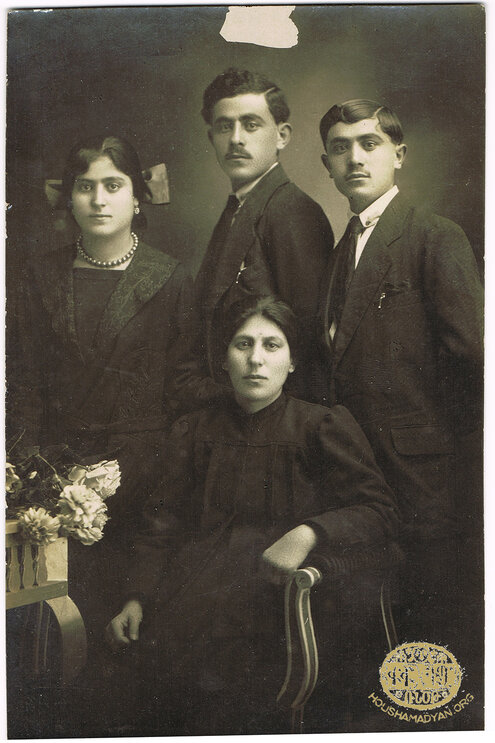



The identities of the people in the photo are unknown.



The identities of the people in the photo are unknown.













